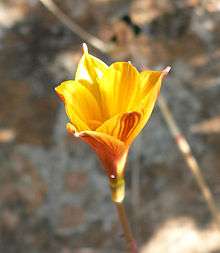Habranthus
Habranthus (copperlily)[1] is a genus of tender herbaceous flowering bulbs in the subfamily Amaryllidoideae of the family Amaryllidaceae.[2] The genus was first identified by pioneering bulb enthusiast William Herbert in 1824. The species are native to the Americas, from (Arizona, New Mexico, Texas, Mexico, Bolivia, Brazil, Argentina, Paraguay and Uruguay), but several species are naturalized in other parts of the world West Indies, India, South Africa, Mauritius, Colombia, Easter Island, and the southeastern United States.[3]
| Habranthus | |
|---|---|
 | |
| Habranthus tubispathus | |
| Scientific classification | |
| Kingdom: | Plantae |
| Clade: | Tracheophytes |
| Clade: | Angiosperms |
| Clade: | Monocots |
| Order: | Asparagales |
| Family: | Amaryllidaceae |
| Subfamily: | Amaryllidoideae |
| Subtribe: | Hippeastrinae |
| Genus: | Habranthus Herb. |
| Synonyms | |
| |
Description
Along with Zephyranthes and Cooperia, Habranthus is one of several related genera commonly known as rain lilies. All three have starry, funnel-shaped flowers and are native to tropical and semi-tropical regions of the Americas. Flowers are either solitary or in umbels of up to 4 flowers,[4] and typically appear in late spring through to autumn in response to rain. Individual bulbs are often capable of blooming more than once per year.[5]
Habranthus is distinct from Zephyranthes in holding its flowers at an angle rather than upright and in having unequal stamens.[6] It also has less symmetrical flowers.
Taxonomy
At one stage, Habranthus was considered a subgenus of the closely related Hippeastrum.[7] Now it is located in tribe Hippeastreae, subtribe Hippeastrinae.
Cultivation
In the United States, Habranthus, like other rain lilies, is regarded as an "heirloom plant", although it is not widely used in mainstream landscapes, perhaps because its bloom time, dependent on rain, is erratic. Nevertheless, the bulbs are rugged and easy to grow in USDA Hardiness Zones 8-10 and are recognized among bulb specialists as possessing distinct landscape value in appropriate areas of the world.[8] In colder regions they may be grown in sheltered sites, or in pots kept frost-free in winter.[6]
The most commonly grown species are the pink-flowered H. robustus and the yellow-flowered H. tubispathus.[6]
List of species
The list of species accepted by the World Checklist of Selected Plant Families as of May 2011 is shown below.[9]
- Habranthus albispiritus Ravenna
- Habranthus amambaicus Ravenna
- Habranthus andalgalensis Ravenna
- Habranthus araguaiensis Ravenna
- Habranthus arenicola (Brandegee) Flagg
- Habranthus auratus Ravenna
- Habranthus bahiensis Ravenna
- Habranthus barrosianus Hunz. & Di Fulvio
- Habranthus botumirimensis R.S.Oliveira
- Habranthus brachyandrus (Baker) Sealy
- Habranthus caaguazuensis Ravenna
- Habranthus caeruleus (Griseb.) Traub
- Habranthus calderensis Ravenna
- Habranthus cardenasianus Traub & I.S.Nelson
- Habranthus carmineus Ravenna
- Habranthus catamarcensis Ravenna
- Habranthus chacoensis Ravenna
- Habranthus chichimeca (T.M.Howard & S.Ogden) Flagg
- Habranthus concinnus Ravenna
- Habranthus conzattii (Greenm.) Flagg
- Habranthus cordobensis Ravenna
- Habranthus correntinus Roitman
- Habranthus crassibulbus Ravenna
- Habranthus datensis Ravenna
- Habranthus duarteanus Ravenna
- Habranthus erectus Ravenna
- Habranthus estensis Ravenna
- Habranthus gameleirensis Ravenna
- Habranthus goianus Ravenna
- Habranthus gracilifolius Herb.
- Habranthus guachipensis Ravenna
- Habranthus immaculatus Traub & Clint
- Habranthus irwinianus Ravenna
- Habranthus ischihualastus Ravenna
- Habranthus itaobinus Ravenna
- Habranthus jamesonii (Baker) Ravenna
- Habranthus jujuyensis (E.Holmb.) Traub
- Habranthus lacteus (S.Moore) Ravenna
- Habranthus leonensis Ravenna
- Habranthus leptandrus Ravenna
- Habranthus longifolius (Hemsl.) Flagg
- Habranthus longipes (Baker) Sealy
- Habranthus lucidus R.S.Oliveira
- Habranthus maasii Ravenna
- Habranthus magnoi Ravenna
- Habranthus martinezii Ravenna
- Habranthus matacus Ravenna
- Habranthus medinae L.O.Alvarado & García-Mend.
- Habranthus mendocensis (Baker) Sealy
- Habranthus mexicanus T.M.Howard
- Habranthus microcarpus (Rusby) Ravenna
- Habranthus millarensis Ravenna
- Habranthus minor Ravenna
- Habranthus neumannii Roitman
- Habranthus niveus Ravenna
- Habranthus nullipes Ravenna
- Habranthus oaxacanus T.M.Howard
- Habranthus oltanus Ravenna
- Habranthus oranensis Ravenna
- Habranthus pantanalensis Ravenna
- Habranthus pedunculosus Herb.
- Habranthus philadelphicus Ravenna
- Habranthus pictus Ravenna
- Habranthus quilmesianus Ravenna
- Habranthus riojanus Ravenna
- Habranthus robustus Herb. ex Sweet - Pink Rain Lily
- Habranthus ruber Ravenna
- Habranthus ruizlealii Ravenna
- Habranthus saipinensis Ravenna
- Habranthus salinarum Ravenna
- Habranthus saltensis Ravenna
- Habranthus sanavirone Roitman
- Habranthus schulzianus Ravenna
- Habranthus spectabilis Ravenna
- Habranthus steyermarkii Ravenna
- Habranthus sylvaticus (Mart. ex Schult. & Schult.f.) Herb.
- Habranthus tepicensis Greenm. ex Flagg & G.Lom.Sm.
- Habranthus teretifolius (C.H.Wright) Traub & Moldenke
- Habranthus tubispathus (L'Hér.) Traub - Copper Lily
- Habranthus unifolius (Arechav.) Traub
- Habranthus venturianus Ravenna
- Habranthus vittatus T.M.Howard
References
- "Habranthus". Natural Resources Conservation Service PLANTS Database. USDA. Retrieved 9 May 2015.
- Stevens, P.F., Angiosperm Phylogeny Website: Asparagales: Amaryllidoideae
- Kew World Checklist of Selected Plant Families Habranthus
- Flagg, Raymond O.; Smith, Gerald L. & Flory, Walter S. (1982), "Habranthus", in Flora of North America Editorial Committee (ed.), Flora of North America, Oxford University Press, p. 55, retrieved 2015-02-11
- Fellers, John D. "A Passion for Rainlilies: Cooperia, Habranthus, and Zephyranthes." Herbertia 51, 1996, pp 78-112
- Mathew, Brian (1987), The Smaller Bulbs, London: B.T. Batsford, ISBN 978-0-7134-4922-8, p. 101
- Baker, John Gilbert (1888). "Hippeastrum". Handbook of the Amaryllideæ including the Alstrœmerieæ and Agaveæ. London: Bell. p. 41. Retrieved 31 March 2014.
- Ogden, Scott. Garden Bulbs for the South. Dallas, TX: Taylor Publishing Co., 1994, pp 5-27
- WCSP (2011), World Checklist of Selected Plant Families, The Board of Trustees of the Royal Botanic Gardens, Kew, retrieved 2011-05-23, search for "Habranthus"
- Howard, Thad M. Bulbs for Warm Climates. Austin, TX: University of Texas Press, 2001, pp 77–82.
External links
- International Bulb Society's gallery of photographs
- Pacific Bulb Society's gallery of photographs
- Habranthus entry in Flora of North America
- World Checklist of Selected Plant Families:276628
| Wikispecies has information related to Habranthus |
| Wikimedia Commons has media related to Habranthus. |
.jpg)
